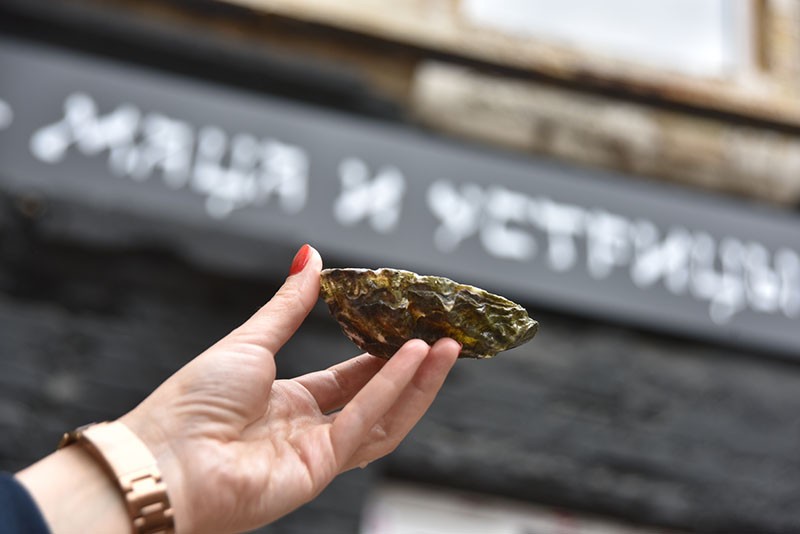What do you do if you own the biggest (and only) oyster farm in Ukraine? Open an oyster bar, of course.
The bar, called Matza and Oysters, opened in Kyiv on May 19. The owners say their restaurant, like their farm, is one of a kind.
The new bar not only serves the drinks that go best with its oysters, but also offers a range of cocktails that include raw oysters.
Serge Stakhov, 28, and Andre Pigulevsky, 35, call themselves Ukrainian Jews, though they obviously don’t follow the kosher dietary laws. But they said they respect those who do keep kosher, and there are kosher options on their bar’s menu as well.
“In this place we wanted to combine two things that are close to us — oysters and Jewish cuisine,” Stakhov says. “Our chef worked in Tel Aviv, Israel, for two years. It will be really tasty and cheap.”
Matza and Oysters works only on Thursday, Friday and Saturday nights. It has hummus with lamb on the menu, and will offer a different kind of grilled meat and seafood each week.
However, the main feature of the bar is still the oysters — the freshest in Kyiv, the bar’s co-founders say.
Their company Skifian Oysters produces up to 4 tons of oysters a month. The farm in Odesa Oblast supplies oysters to more than 400 restaurants all over Ukraine and to all of the big supermarket chains.
Matza and Oysters is the only place, the owners say, where the oysters won’t have been kept in refrigerators, but will be served right from special reservoirs of sea water. Pigulevsky says the oysters not only stay fresh in these reservoirs, but can continue to live and grow, as the water contains all the vital elements and sea microorganisms they need.
10 days without water
Pigulevsky plunges his hand into the cool water of one of the big containers, and fishes out several oysters.
“When you pick out an oyster, make sure the shell is shut tightly,” he says. “It means the mollusk inside is alive.”
An oyster can live in a refrigerator for about 10 days. Then, if it’s not put back into sea water, it dies, opens up, and becomes inedible. Pigulevsky opens the shell with a knife.
“Don’t feel bad, an oyster has neither a brain nor a central nervous system. It doesn’t feel pain,” he says.
But Stakhov warns that people usually don’t appreciate the taste of oysters at first.
“Andre and myself, we’ve eaten so many of them,” he says, smiling. “We still love them though.”
Healthy food
Mutual friends introduced Pigulevsky and Stakhov some four years ago. They soon became friends, partly because they shared an interest — healthy eating.
This was also the reason they chose to farm oysters, which, according to Pigulevsky, are very nutritious. The two friends traveled across the Europe, trying oysters, and decided to bring the shellfish back to Ukraine.
They discovered that oysters had been a popular and cheap food in Ukraine before the early 20th century, until the Bolsheviks came to power and squeezed the oyster business out of the Black Sea, considering the shellfish a bourgeois food.

One of the employees of the Skifian Oysters holds an oyster near the entrance to Matza and Oysters bar in Kyiv on May 16. (Oleg Petrasiuk)
After several failed attempts, Pigulevsky and Stakhov in 2014 finally found the perfect place in Odesa Oblast, where they successfully raised some young oysters they had bought from an oyster farm in France.
It takes an oyster about 18 months to grow to the commercial size at which it can be sold.
Big plans
According to Stakhov, Skifian Oysters meets about 40 percent of Ukraine’s domestic demand for oysters. The remaining 60 percent is imported.
Now, with their farm growing, the partners plan to ramp up production and enter the European market.
Stakhov says Ukrainian oysters’ taste is more delicate, since the water in the Black Sea is less salty than, for example, in the Mediterranean Sea. Ukrainian oysters are also cheaper than those raised in Europe.
To export their oysters, the partners will also have to receive a European quality certificate, which they say costs a six-figure amount of dollars.
“(But) in several years we will be feeding the whole of Europe,” Stakhov says.
Matza and Oysters. 39 Dmytrivska St. Open Thursday-Saturday starting from 7 p. m. and until the last customer.
To order fresh oysters go to www.skifian.com.ua/zakazat and fill in the short form (name, city, email address, phone number and the amount of oysters). There is no English version of the website, but the owners say their employees can take the orders in English at +38063–999–2101. The price starts from Hr 33 per oyster.
